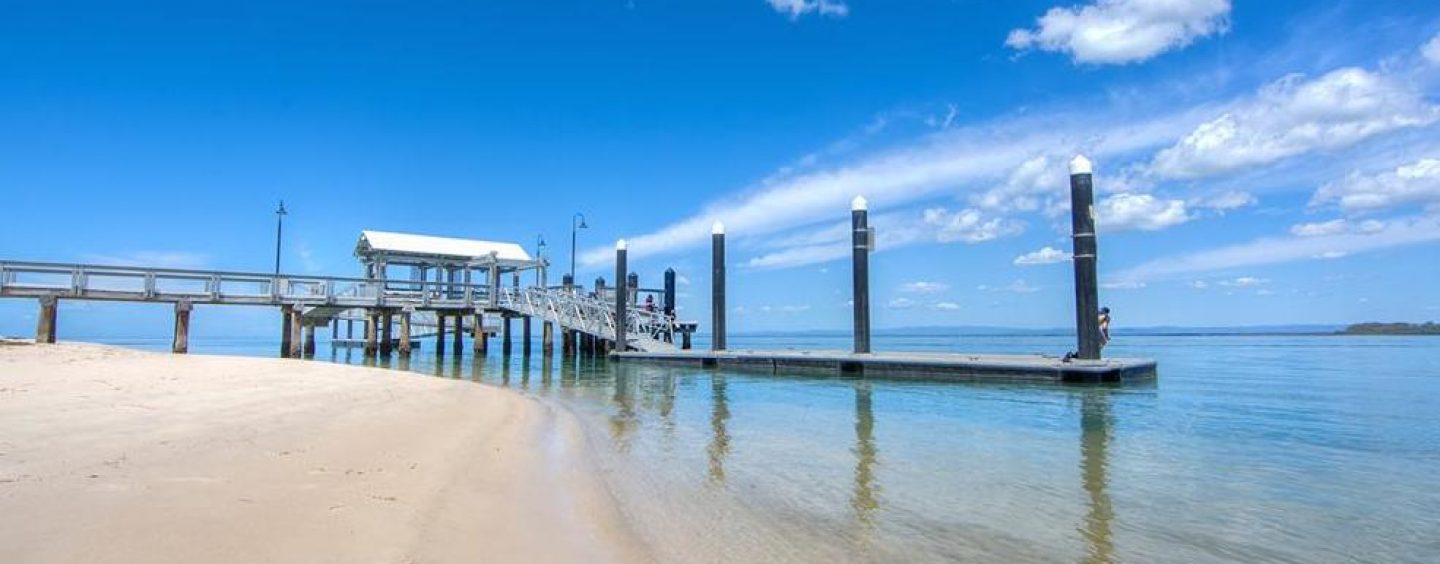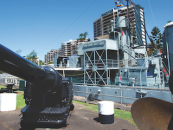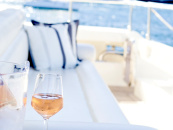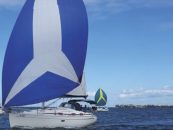At the northern part of Moreton Bay is Bribie Island, a 34-km long sand island blessed with natural beauty of white sandy beaches and an abundant marine park.
The beauty of Bribie is that it has retained a small seaside village charm, while offering some of the most stunning scenery on the east coast of Queensland. The island is a beautiful yet sleepy place that has a laid-back casual vibe. It feels untouched – no towering skyscrapers and apartment buildings.
There are so many things to do on Bribie Island with plenty of natural and man-made attractions. You can relax while sitting on a secluded sand dune, walk through the lush national parks, explore the regular community markets, or slowly navigate the Pumicestone Passage.
HISTORY
This island was traditionally the home of the Gubbi Gubbi Aboriginal group who used bark canoes, nets for fishing and catching birds, and spears for hunting the local kangaroos and wallabies. They also used stone traps to catch fish and left middens on the coasts as evidence of their existence.
Natural resources of land and sea were abundant and harvested according to the seasons. Winter mullet schooled from May to July. Dolphins were trained to herd the fish into waiting nets and spears. Winter was the best season for bream, followed by tailor in September and October. In summer, mud crabs and oysters were plentiful and dugongs were hunted. Summer whiting and flathead were speared or netted. The dominant shellfish used as food was the oyster locally known as tibir, which at that time was growing naturally on the seabeds. However, by 1897, there were no more Aborigines left on the island.
Matthew Flinders first landed in 1799 to make repairs to his vessel, the Norfolk. Unfortunately, Flinders did not realise that Bribie was an island, and consequently did not find the entrance to the Brisbane River.
The origin of the name Bribie are believed to be linked to a convict named Bribie or Breiby who gathered basket-making material on the island in the 1830s. He was also supposedly an expert at mud crabbing for the officers and was eventually rewarded with his freedom living out his life on the island with a local Aboriginal woman.
The development of the island has been slow, but changed dramatically in 1963 when the Bribie Island Bridge from the mainland was completed. This opened the island up to holidaymakers and daytrippers.
WATERWAYS
The Pumicestone Passage connects to the sea at each end of the island. It is a haven for endangered migratory birds and marine mammals. The dugongs frequent these waters seasonally to feed on the seagrass. Dolphins and turtles also make the passage home, as do over 350 species of birds.
A series of environmental protection programs, covering both its marine life and vegetation, has been put in place to preserve Bribie Island’s internationally significant ecological values. Recreational fishing is permitted in the Pumicestone Passage, which forms part of the Moreton Bay Marine Park, with the exception of Tripcony Bight (Long Island and Westaways Creek marine national park zones).
Those on the Passage are expected to take precautions to protect the endangered dugong population, including travelling at slow speed over seagrass beds, observing “Go Slow” zones at Tripcony Bight, Long Island and Westaways Creek, using bait-disposal bags and safely disposing of plastic and other foreign objects.
Pumicestone Passage’s extensive tidal wetlands are essential breeding areas for many fish, crabs and prawns. During winter, the passage between Bells Creek and Caloundra Bar is one of Southeast Queensland’s principal spawning areas for yellowfin bream. Flathead, bream, whiting, tailor and mangrove jack are often caught around Bribie Island. Many people catch sand and mud crabs during the summer months.
PUMICESTONE PASSAGE
Bribie Island is separated from the mainland by the Pumicestone Passage Marine Park, which has 24 islands and is bounded by 240 kilometres of shoreline.
Pumicestone Passage provides deep-water access to most boats, although care must be taken to avoid the shallow areas and sand banks, which are suitably marked on most GPS maps with shallow waterways ranging from one to 12 metres. Boats up to 5 metres in length can navigate to Caloundra during the high tides, but low tide can see you stranded half way. Most small displacement vessels can navigate easily (best at top half of tide) to a sheltered anchorage suitable in all weather conditions. The bottom is mainly sand and mud, although there are some rocks and coffee rock on the shoreline.
Some of the popular destinations along the passage as far north as Mission Point (town of Toorbul) where there is a public pontoon to tie. Other interesting anchorages are at Elimba Creek, (town of Donnybrook), Gallaghers, and Poverty Creek.
Safe anchorage is available in the southern entrance of Pumicestone Passage.
Be aware of weather forecasts. South of the Bribie Bridge can be quite rough water and there are also strong currents to consider when anchoring. For larger boats and those with masts, you should be aware of your height coming under the bridge, which has an air draft of 5 metres.
Another possible anchorage south of the bridge is Bongaree. There you will find the Bongaree jetty, which accommodates small to large boats for short-term berth (no overnight tie ups). Alternatively, you can drop anchor all along Bongaree foreshore. From here, there is easy access to Moreton Bay, and the Tangalooma Resort. However, if whale watching is more your style, you can safely navigate to Cape Moreton, Flinder’s Reef or Hutchison’s Shoal, which are also great fishing destinations.
MARINA BERTHS
There are two marinas in the Bribie Island area. The Spinnaker Sound Marina is located about 100m north of the Bribie Island Bridge on your port side, which has casual overnight berths, and many of the amenities, such as fuel, showers, toilets and restaurants. The other marina, ideal for an overnight berth, is Pacific Harbour Marina, located about 1km north on your starboard side up the Pumicestone Passage from the Bribie Island Bridge. When entering into the marina, you will be amazed by the million dollar homes, two of which have won Queensland House of the Year. The marina offers showers, toilets, power and freshwater.
TRAILER BOATS BY LAND
If you are arriving by land, you can explore the surf side, Woorim and the Bribie Island National Park. The island is a great destination for all ages, as well as young families. The eastern beaches are protected by Moreton Island so the surf consists of small waves suitable for young children. The main beach is patrolled by the Surf Life Savers during daylight hours.
Bribie Island offers a host of accommodation ranging from caravan parks to four-star motels. There are camping sites, but most of these can only be accessed by 4WD vehicles. The 4WD permits are available and will enable you to drive along most of the beach, as well as the inland road located on the western side of the island. The white sand beach stretches for over 30 kilometres and provides a great sense of relaxation and escape. Scattered along the sand dunes facing Moreton Bay are a series of WWII-built forts and gun emplacements.
Camping areas accessible by 4WD include Gallagher Point bush camping, Poverty Creek and Ocean Beach (16km north of the beach access point at Woorim). Camp sites at Ocean Beach are tucked away behind the dunes. Campsites for visitors arriving by boat are available at Mission Point and the Lime Pocket camping area. Camping permits are required and fees apply. Other places to stay include Bribie Waterways Motel, Bribie Island Hotel, The Gums Anchorage, Bribie Island Caravan Park, and Bongaree Caravan Park.
Bribie Island boasts at least 7 boat ramps, providing easy access to the water. The amenities are excellent, including toilets, BBQs, grassy picnic areas, playgrounds, safe waters for swimming, car parking, pontoons, boat hire, VMR and fish cleaning stations.
Once on water, you can explore the waterways on the north side of the Bribie Bridge, even on the high tide, navigating up through the Skids and W’s to Caloundra. The Caloundra Boat Club has full club facilities at Golden Beach. Alternatively, visit the Blue Hole and walk over the northern dunes of Bribie Island to the beach and watch all shipping traffic for Port of Brisbane pass only a few hundred metres away, while you play cricket on the beach.
DINING SCENE
There are numerous restaurants available within fifteen minutes’ drive. There is an RSL and a few bowls clubs that offer bus pick-up services. The Sandstone Point Hotel is a new music and dining venue accessible by boat via a pontoon. Note, just south of the pontoon is an old oyster lease that is quite dangerous, as you cannot see it at high tide, so it is strongly recommend to always approach from the North.
Other local favourites are Bribie Island Hotel, Charlie’s Restaurant at Sylvan Beach, and Dock & Dine Restaurant at Spinnaker Marina. There are a good selection of food outlets in Bongaree from coffee shops, a bakery and famous Savige’s Seafood, which is definitely worth a try.
At the east end of the island, the Blue Anchorage Hotel and the Surf Club offer dining destinations near the surf beaches, while the local café provides a variety of light meals including hot chips and ice cream.
MUST VISIT TREASURE
Bribie Island Seaside Museum at Bongaree (tie up at Bongaree Jetty pontoon) gives a good history, from the arrival of Matthew Flinders to the present day. The museum showcases Flinders’ encounter with the Aboriginal people at Skirmish Point, American troop occupation in WWII, as well as stories of Bribie and the people who shaped the island’s history.
The island also hosts the Bribie Island Annual Classic Boat Regatta scheduled for 24 – 26 May 2019.
FRIENDLY LOCALS
This boater’s preview of Bribie Island could not have been written without information provided by these friendly locals.
Frank Oostenbroek is the public relations officer at Bribie Island RSL Social Fishing Club. He has 45 years of trailer boat experience and a further 15 years experience with boats over 10 meters. Frank has lived on Bribie Island for 16 years. bribierslfishingclub.com
Dr Doug Wilson is CEO Bribie Island Boating Club, which also comprises the sailing club and outrigger canoe club. Doug has been sailing since 1975, and has lived on Bribie Island since 1997. He has also been a member of VMR Bribie since 2002. bribieislandboatingclub.org.au
Quinn Pryde is the owner and skipper of Bribie Island Gondola Islander who has been offering sunrise to sunset and evening cruises since 2014. bribieislandgondola.com.au
By Andy Kancachian
Read more about boating through the Pumicestone Passage: boatgoldcoast.com.au/ conquering-the-pumicestone-passage/






























